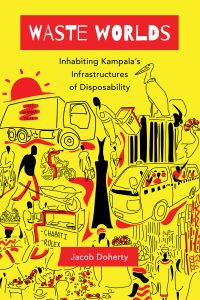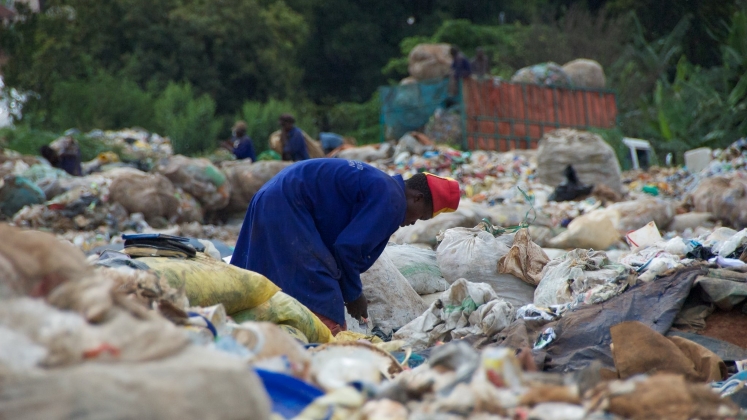In Waste Worlds: Inhabiting Kampala’s Infrastructures of Disposability, Jacob Doherty explores how waste materialises struggles around disposability and development for the people of Kampala. Written in evocative prose, this book is a valuable addition to the ethnography of waste in the Global South and shows how the politics of waste can shape a city and marginalise its poorer inhabitants, writes Dagna Rams.
Waste Worlds: Inhabiting Kampala’s Infrastructures of Disposability. Jacob Doherty. University of California Press. 2021.
 A common assessment of cities in the global South – voiced by residents and outsiders – is that their waste is getting out of hand. Such an assessment, however, is often made without considering the complicated politics of waste in contexts where municipalities struggle to match funding with the immense scale of disposability and where social inequalities are often baked into waste management. It is the history and present life of those complicated politics that Jacob Doherty considers in Waste Worlds. The book follows in the footsteps of other important ethnographies of waste infrastructures in the Global South, notably Rosalind Fredericks’ Vital Infrastructure and Kathleen Millar’s Reclaiming the Discarded. Doherty takes readers to Uganda’s capital of Kampala, a sprawling city in East Africa, and shows us its “waste worlds,” that is, how waste is implicated in the debates and interventions concerning what the city ought to look like, which of its residents are welcome or to be evicted from its limits, and which of their comportments are sanctioned.
A common assessment of cities in the global South – voiced by residents and outsiders – is that their waste is getting out of hand. Such an assessment, however, is often made without considering the complicated politics of waste in contexts where municipalities struggle to match funding with the immense scale of disposability and where social inequalities are often baked into waste management. It is the history and present life of those complicated politics that Jacob Doherty considers in Waste Worlds. The book follows in the footsteps of other important ethnographies of waste infrastructures in the Global South, notably Rosalind Fredericks’ Vital Infrastructure and Kathleen Millar’s Reclaiming the Discarded. Doherty takes readers to Uganda’s capital of Kampala, a sprawling city in East Africa, and shows us its “waste worlds,” that is, how waste is implicated in the debates and interventions concerning what the city ought to look like, which of its residents are welcome or to be evicted from its limits, and which of their comportments are sanctioned.
Doherty takes readers to Uganda’s capital of Kampala, a sprawling city in East Africa, and shows us its ‘waste worlds,’ that is, how waste is implicated in the debates and interventions concerning what the city ought to look like
The author’s theoretical innovation is to treat waste and cleaning, disposability and development, as interrelated processes. What are the different notions of waste and cleaning? Whose comportments are seen as wasteful and whose are seen to progress a clean city? Who is seen to be disposable to make way for new development? Attention to these intersections is crucial as Kampala, like many other cities in the region, grows and transforms amid aspirations to attract global capital and conform to its aesthetics that conflict with the realities of most residents. Waste Worlds documents examples of such dissonance between the aspirational and real. One of the stark examples is the 2011 bulldozing of a public housing estate from the 1950s to make way for a city development planned and funded by a UK-based property firm with architect David Adjaye at the helm. The project never materialised but it resulted in a violent erasure of people’s homes and building waste, as represented in a local newspaper’s image of “a young woman with a baby clasped against her chest, leaning against the remaining wall of a half-demolished room, her belongings strewn around her as a bulldozer exits the frame, leaving her amid the rubble of her razed home” (58).
What are the different notions of waste and cleaning? Whose comportments are seen as wasteful and whose are seen to progress a clean city? Who is seen to be disposable to make way for new development?
The book’s discussion is grounded in ethnography as concepts emerge from ethnographic vignettes. Waste Worlds is published within the Atelier series at the University of California, which promises to innovate ethnographic inquiry in the twenty-first century. The prose is evocative with a skilful poetic style: waste is likened to “photographic negatives of the commodity flows defining planetary urbanism” (xii) and money in waste economies “works as a kind of deodorant, not only uncontaminated by the dirty work of procuring it [waste] but also able to cleanse workers of the judgmental gaze of others who might despise them” 112). The book is divided into three parts – “Authority of Garbage”, “Away”, and “Racializing Disposability”, each comprising short chapters. These chapters act as perfect conversation starters for a wider public seeking to make sense of waste in sub-Saharan urban contexts – this is because the chapters centre on concrete examples that render the political valence to crucial terms such as ‘informality’, ‘development’ or ‘waste’ that might otherwise be approached as straightforward. The book is also full of potent reflections about the author’s positionality as a white researcher seeking to justify his project to his interlocutors in Kampala. Doherty includes sequences of self-reflection and snippets of conversations in which interviewees challenge him and shows how these moments in turn influence his research and writing. In the book’s preface, he is spurred by a trader named Aisha who wonders why he would study waste in Uganda (“Don’t you have garbage in your country?”) to consider how to make his project relevant to global debate about waste (for which Uganda is a country like many others in its income group) and a regional call not to reduce developments in Africa to a narrative of failure or mismanagement.
The chapters centre on concrete examples that render the political valence to crucial terms such as ‘informality’, ‘development’ or ‘waste’ that might otherwise be approached as straightforward
Part One, “Authority of Garbage” treats waste as an object of governance and looks at how waste is implicated in the constitution of political authority. We learn of the reign of Kampala’s former director Jennifer Musisi which coincided with Doherty’s fieldwork in early 2010s. Her leadership was characterised by the extension of waste management services to previously underserviced neighbourhoods, but also by the controversial suppression of livelihoods of poor people such as roadside trading and waste picking. Such policies, however, were contested by residents and public figures such as Bobi Wine. The now famous opposition leader sang about the struggles of Kampala’s underprivileged residents and the excesses of power. His “TUGAMBIRE KU JENIFFER” (“Speak with Jennifer”) documents the municipal practice of rounding up unwelcome sellers onto a truck to evict them from the city and speaks to the popular sentiment.
Part Two, “Away” approaches waste as an object of labour. The section focuses on the urban margins that act as “sinks” for waste and the waste pickers who step in as waste “spills” beyond the centrally managed waste infrastructure. This section introduces the notion of “para-sites,” that is, “social spaces where disparate cultures meet, clash and grapple with each other, often in highly asymmetrical relations of domination and subordination” (85). The author effectively shows how so-called urban “surplus populations” (a problematic trope in much writing about sub-Saharan cities) provide cheap work such as waste picking that can be useful to the state but are otherwise not acknowledged for their efforts. Treated as second-class citizens, these people are denied having a say in how their cities are being shaped and developed.
So-called urban ‘surplus populations’ (a problematic trope in much writing about sub-Saharan cities) provide cheap work such as waste picking that can be useful to the state but are otherwise not acknowledged
Finally, Part Three “Racializing Disposability” explores how “race is a silent, yet constitutive, element of the normative understanding of development” (174) including when it comes to waste. One of the key ideas introduced in this section is the notion of “infrastructures of feeling” which proposes that urban infrastructures engender affects among the public which are cultivated to achieve political ends. Landfills, roads, pipes and so on are objects of desire that encapsulate a better future and political efficacy. In the post-colonial context, such desires are conditioned by colonial and post-colonial racial hierarchies which – in Doherty’s telling – associate development with whiteness and cast Africans as lacking. Doherty shows the presence of racialising and anti-Black tropes in inter alia the language of President Museveni whose past speeches would refer to Ugandans as lazy and irresponsible. Such forms of racialisation obfuscate effects of class differences or material conditions on living standards and rather attribute poor living standards to supposed innate qualities. For example, problems with garbage in poorer neighbourhoods are seen by those in power as expressive of the residents’ supposed backwardness rather than insufficient access to waste services (see Chapter 13, “Waste in Time”).
Landfills, roads, pipes and so on are objects of desire that encapsulate a better future and political efficacy. In the post-colonial context, such desires are conditioned by colonial and post-colonial racial hierarchies
Together with aforementioned texts by Fredericks and Millar, Waste Worlds offers a way to think about waste that humanises waste workers and renders the complicated experience of waste for non-elite urban residents. Doherty adds to this discourse a new mode of understanding urban transformation by linking waste to larger themes of development and disposability. The book’s ethnographic approach shows how to document and interpret waste as a key component in debates around care (for the city and others), blame and responsibility in urban settings in the Global South. Waste here is a testament of capitalist excesses that redefines the targets of municipal rule and markers of its success by creating new infrastructural demands. The presence of waste in urban spaces meanwhile becomes a basis for forming judgements about poorer people who, cut from adequate municipal services, struggle to contain it. Doherty’s work emphasises the importance of an inclusive approach to urban transformation.
Note: This review gives the views of the author, and not the position of the LSE Review of Books blog, or of the London School of Economics and Political Science. The LSE RB blog may receive a small commission if you choose to make a purchase through the above Amazon affiliate link. This is entirely independent of the coverage of the book on LSE Review of Books.
Main Image: Lars Schoebitz on Flickr.


